Volkskammer
The Volkskammer (German: [ˈfɔlkskamɐ], People's Chamber) was the unicameral legislature of the German Democratic Republic (colloquially known as East Germany).
People's Chamber Volkskammer | |
|---|---|
| German Democratic Republic | |
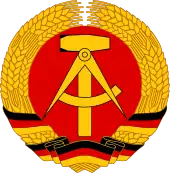 Emblem | |
| Type | |
| Type | |
| History | |
| Founded | 7 October 1949 |
| Disbanded | 3 October 1990 |
| Preceded by | Reichstag (Nazi Germany) 1933–1945 Länderkammer (East Germany) 1949–1958 |
| Succeeded by | Bundestag |
| Leadership | |
President | Johannes Dieckmann (first) Sabine Bergmann-Pohl (last) |
Vice President/Deputy President | (first presidium) Hermann Matern Gerald Götting Ernst Goldenbaum Heinrich Homann Vincenz Müller (last presidium) Reinhard Höppner Käte Niederkirchner Jürgen Schmieder Wolfgang Ullmann Dieter Helm Stefan Gottschall |
| Structure | |
| Seats | 400 |
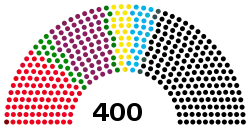 | |
Political groups | Government (303)
Opposition (97)
|
| Elections | |
| Direct show elections | |
First election | 15 October 1950 |
Last election | 18 March 1990 |
| Meeting place | |
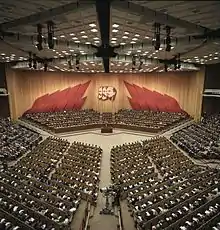 | |
| Palace of the Republic, Berlin | |
| Constitution | |
| Constitution of East Germany | |
Politics of East Germany |
|---|
 |
|
The Volkskammer was initially the lower house of a bicameral legislature. The upper house was the Chamber of States, or Länderkammer, but in 1952 the states of East Germany were dissolved, and the Chamber was abolished in 1958. Constitutionally, the Volkskammer was the highest organ of state power in the GDR, and both constitutions vested it with great lawmaking powers. All other branches of government, including the judiciary, were responsible to it. By 1960, the chamber appointed the Council of the State, the Council of Ministers, and the National Defence Council. In practice, however, it was a pseudo-parliament that did little more than rubber-stamp decisions already made by the SED — always by unanimous consent — and listen to the General Secretary's speeches.
Membership
In October 1949 the Volksrat charged with drafting the Constitution of East Germany proclaimed itself the Volkskammer and requested official recognition as a national legislature from the Soviet Military Administration in Germany. This was granted by Soviet Deputy Foreign Minister Andrei Gromyko. The Volkskammer then convened with the Landerkammer to elect Wilhelm Pieck as the first President of East Germany and Otto Grotewohl as the first Prime Minister of East Germany.[1]
From its founding in 1949 until the first competitive elections in March 1990, all members of the Volkskammer were elected via a single list from the National Front, a popular front/electoral alliance dominated by the SED. In addition, seats were also allocated to various organizations affiliated with the SED, such as the Free German Youth. Effectively, the SED held control over the composition of the Volkskammer.[2] In any event, the minor parties in the National Front were largely subservient to the SED, and were required to accept the SED's "leading role" as a condition of their continued existence.[3]
The members of the People's Chamber were elected in multi-member constituencies, with four to eight seats. To be elected, a candidate needed to receive half of the valid votes cast in their constituency. If, within a constituency, an insufficient number of candidates got the majority needed to fill all the seats, a second round was held within 90 days. If the number of candidates getting this majority exceeds the number of seats in the respective constituency, the order of the candidates on the election list decided who got to sit in the Volkskammer. Candidates who lost out on a seat because of this would become successor candidates who would fill casual vacancies which might occur during a legislative period.[4]
Only one list of candidates appeared on a ballot paper; voters simply took the ballot paper and dropped it into the ballot box. Those who wanted to vote against the National Front list had to vote using a separate ballot box, without any secrecy.[5] The table below shows an overview of the reported results of all parliamentary elections before 1990, with the resulting disposition of parliamentary seats.
| Election | Turnout | Agree | Distribution of parliamentary seats | |||||||||||
|---|---|---|---|---|---|---|---|---|---|---|---|---|---|---|
| SED | CDU | LDPD | DBD | NDPD | FDGB | FDJ | KB | DFD | SPD1 | VdgB | VVN | |||
| 1950 | 98.53% | 99.9% | 110 | 67 | 66 | 33 | 35 | 49 | 25 | 24 | 20 | 6 | 12 | 19 |
| 1954 | 98.51% | 99.4% | 117 | 52 | 52 | 52 | 52 | 53 | 29 | 29 | 18 | 12 | ||
| 1958 | 98.90% | 99.9% | 117 | 52 | 52 | 52 | 52 | 53 | 29 | 29 | 18 | 12 | ||
| 1963 | 99.25% | 99.9% | 127 | 52 | 52 | 52 | 52 | 68 | 40 | 35 | 22 | |||
| 1967 | 99.82% | 99.9% | 127 | 52 | 52 | 52 | 52 | 68 | 40 | 35 | 22 | |||
| 1971 | 98.48% | 99.5% | 127 | 52 | 52 | 52 | 52 | 68 | 40 | 35 | 22 | |||
| 1976 | 98.58% | 99.8% | 127 | 52 | 52 | 52 | 52 | 68 | 40 | 35 | 22 | |||
| 1981 | 99.21% | 99.9% | 127 | 52 | 52 | 52 | 52 | 68 | 40 | 35 | 22 | |||
| 1986 | 99.74% | 99.9% | 127 | 52 | 52 | 52 | 52 | 68 | 37 | 21 | 32 | 14 | ||
1 Eastern Bureau of the Social Democratic Party of Germany
In 1976, the Volkskammer moved into a specially constructed building on Marx-Engels-Platz (now Schloßplatz again), the Palace of the Republic (Palast der Republik). Prior to this, the Volkskammer met at Langenbeck-Virchow-Haus in the Mitte district of Berlin.
Initially, voters in East Berlin could not take part in elections to the Volkskammer, in which they were represented by indirectly elected non-voting members, but in 1979 the electoral law was changed to provide for 66 directly elected deputies with full voting rights.[6]
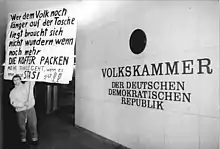
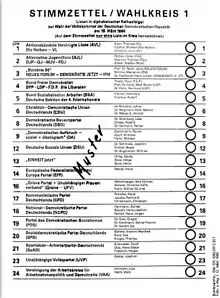
After the 1990 election, the disposition of the parties was as follows:
| Party/Group | Acronym | Members |
|---|---|---|
| Alliance for Germany | CDU, DA, DSU | 192 |
| Social Democratic Party in the GDR | SPD | 88 |
| Party of Democratic Socialism | PDS, former SED | 66 |
| Association of Free Democrats | DFP, FDP, LDP | 21 |
| Alliance 90 | B90 | 12 |
| Green Party and Independent Women's Association | Grüne, UFV | 8 |
| National Democratic Party of Germany | NDPD | 2 |
| Democratic Women's League of Germany | DFD | 1 |
| United Left | VL | 1 |
Presidents of the People's Chamber
The presidency of the People's Chamber was held by a non-Communist for most of that body's existence; only one SED member ever held the title. The president of the People's Chamber was the third-highest state post in the GDR (after the chairman of the Council of Ministers and the chairman of the State Council) and was ex officio vice president of the country during the existence of the office of president. As such, on two occasions, the president of the People's Chamber served as acting president for brief periods in 1949 and 1960.
| Name | Entered office | Left office | Party |
|---|---|---|---|
| Johannes Dieckmann | 7 October 1949 | 22 February 1969 | LDPD |
| Gerald Götting | 12 May 1969 | 29 October 1976 | CDU |
| Horst Sindermann | 29 October 1976 | 13 November 1989 | SED |
| Günther Maleuda | 13 November 1989 | 5 April 1990 | DBD |
| Sabine Bergmann-Pohl | 5 April 1990 | 2 October 1990 | CDU |
The last president of the People's Chamber, Sabine Bergmann-Pohl, was also interim head of state during the last six months of East Germany's existence due to the State Council having been abolished.
See also
- Elections in East Germany
- Presidium of the People's Chamber
- Show election
Notes
- Lower house of bicameral legislature until 8 December 1958
References
- Naimark, Norman M. The Russians In Germany: a History of the Soviet Zone of Occupation, 1945-1949. E-book, Cambridge, Mass.: Harvard University Press, 1995
- Kurt Sontheimer & Wilhelm Bleek. The Government and Politics of East Germany. New York: St. Martin's Press. 1975. p. 66.
- Andreas Malchya: Der Ausba des neuen Systems 1949 bis 1961, Bundeszentrale für politische Bildung, last retrieved 2022-07-28.
- "German Democratic Republic" (PDF). Chron. XX (1985-1986). Inter-Parliamentary Union. pp. 75–77. Retrieved 29 April 2020.
- Sebetsyen, Victor (2009). Revolution 1989: The Fall of the Soviet Empire. New York City: Pantheon Books. ISBN 978-0-375-42532-5.
- Webb, Adrian (9 September 2014). Longman Companion to Germany since 1945. p. 244. ISBN 9781317884231.